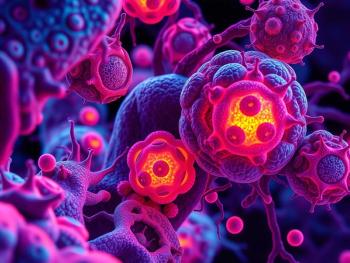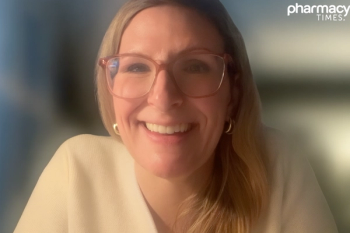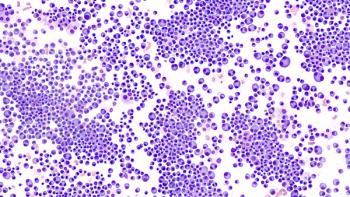
Venetoclax-Based Therapies for Chronic Lymphocytic Leukemia
A hematology expert describes data from clinical trials on venetoclax-based therapies for chronic lymphocytic leukemia.
Episodes in this series

Anthony Perissinotti, PharmD, BCOP: It still again begs the question, do you continue therapy in an MRD [minimal residual disease]-positive patient? And what, a combination or just the single agent? PFS [progression-free survival] is no different, and we have no idea if doing nothing would be no different as well. The 2 ways that I’m interpreting this is, 1, we’re able to achieve MRD negativity more in patients with a combination. But another way to interpret this is that despite more patients achieving MRD negativity, there was no difference in progression-free survival. So again, we’re left with what do we do for these patients that are MRD-positive? I think in future studies we’ll take this knowledge forward and be able to put together newer studies that can adequately address this. There is another combination study called the GLOW study. This was a phase 3 randomized controlled trial of older patients. CAPTIVATE [patients] were less than 70. Here you’ve had patients that were above the age of 65 or so. Patients were randomized to venetoclax [Venclexta] with ibrutinib [Imbruvica] vs chlorambucil and obinutuzumab [Gazyva]. Patients also got that 3-month lead-in with ibrutinib, and then they continued on the combination of ibrutinib/venetoclax for an additional 12 months. So it’s 15 months of therapy and then they stop therapy. Results have been previously reported at the European Hematology Association but here the ASH [American Society of Hematology Annual Meeting 2021] update was primarily looking at what the MRD negativity rates were. This is MRD at 10−4. 52% percent of patients achieved MRD negativity in the bone marrow and 55% in peripheral blood if they got the combination. And this was much, much higher than the chlorambucil/obinutuzumab, which is not surprising at all. Now, if you cross-trial compare, which yes, we shouldn’t do but we all do it, when you take a look at CAPTIVATE or you take a look at CLL14 and those fixed-duration therapies, how many patients achieve MRD negativity at 10−4 in those studies? It was actually higher. It was roughly about 75% of patients. And so this is why you shouldn’t cross-trial compare because now you’re puzzled with why did the MRD negativity rates not get as deep [remissions] with ibrutinib/venetoclax in this regimen, but it did in the other 2 clinical trials that use the combination? Why did it not achieve as deep remissions as venetoclax with obinutuzumab like in CLL14? A lot of it could be the patient population. An older patient population, perhaps they weren’t able to complete their 15 months of therapy. Nonetheless, I don’t think we should really interpret that this was a lower-efficacy study or anything like that. But I think what we should take away from this is this is now another good option for patients. I do anticipate in the next year or so, we will likely see an FDA [Food and Drug Administration] approval for the combination of ibrutinib with venetoclax. Even in patients that don’t achieve MRD negativity, in this study after about a year of therapy, over 90% of patients are still progression-free. So I think that this is a good option for patients. Whether it’s better than our current standard of care, fixed-duration obinutuzumab with venetoclax, it’s an open question. The CLL13 trial actually attempted to answer this question. This was a phase 3 randomized controlled trial that was presented at ASH as well. It’s by the German CLL study group. They had multiple arms in this study. They had obinutuzumab/venetoclax, which is the CLL14 regimen. Then they had obinutuzumab/ibrutinib/venetoclax, so a triple combination. Then they had rituximab [Rituxan] with venetoclax combination. Then they had chemoimmunotherapy, so FCR [fludarabine, cyclophosphamide, and rituximab] or R [rituximab]/bendamustine [Treanda]. It was similar in that there was a lead-in with ibrutinib or a lead-in with obinutuzumab and ibrutinib before the venetoclax. Patients stopped therapy after a certain period of time. It’s roughly about 15 months and then they had some ability for patients to continue on therapy as well if they were not MRD-negative. But this analysis here for the CLL13 is looking at the MRD negativity rates at month 15, so essentially at the end of treatment. So with chemotherapy, only 37% of patients achieved MRD negativity. With rituximab with venetoclax, only 43% of patients achieved MRD negativity. But with the venetoclax-based regimens with obinutuzumab, they achieved about 75% MRD negativity. So, 72.5% with obinutuzumab and venetoclax, and then 78% with the triple combination. These data are much more comparable to CAPTIVATE’s combination and MRD negativity and CLL14’s combination of obinutuzumab with venetoclax. I think this was a very ambitious study and I think we still need longer follow-up to really identify which regimen we should use. But whether we should use obinutuzumab with venetoclax, there wasn’t an arm of ibrutinib with venetoclax. So still some open questions on which combination therapies we should use. I think every patient might have a different reason why we might choose one vs the other. To make things even more complicated, there are multiple ongoing studies that will take a look at other BTK [Bruton tyrosine kinase] inhibitors with venetoclax. We have the AVO study or the MAGIC study that’s using acalabrutinib with venetoclax and obinutuzumab. We’ve got the BOVen regimen with zanubrutinib, obinutuzumab, and venetoclax. That’s primarily all the data that we have that was presented at ASH in regards to other combinations and finite therapies in the frontline setting.
Transcript edited for clarity.
Newsletter
Stay informed on drug updates, treatment guidelines, and pharmacy practice trends—subscribe to Pharmacy Times for weekly clinical insights.




















































































































































































































